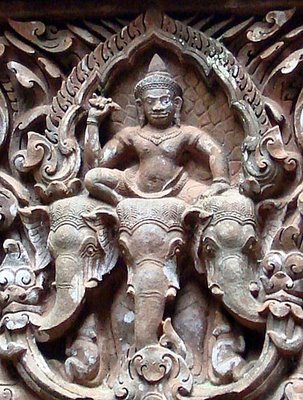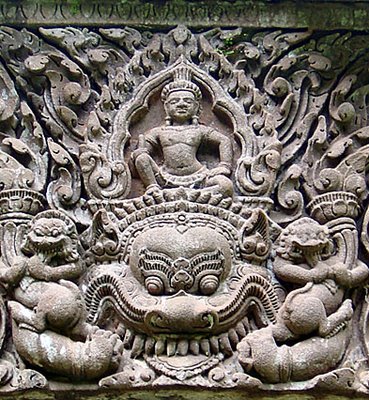Heraldic lintel reliefs
According to the man in the know, namely Vittorio Roveda, the images carved onto the lintels and pediments of Khmer temples can be classified into three types, decorative, heraldic or narrative reliefs. Decorative refers to ornamental motifs such as foliage, garlands and scrolls, pearl strings and occasionally repetitive small figures. Heraldic denotes symbolic figures of men or animals in a static or proclaiming attitude, whilst narrative reliefs depict an event or action that is part of a story. In Khmer reliefs, the events narrated refer either to selected events from Indian or Buddhist mythology, ie, Ramayana or the life of Buddha, or to facts of Khmer history, ie, the battle against the Chams.
The most common type of lintel carving to be seen on Angkorean temples is the heraldic relief. These are normally lintels in which a small, seated deity in the lalisana position (royal ease) on a plinth over the head of the mythological kala. Usually the deity holds a staff of command (danda), a club or a lotus. The kala, or less commonly the makara, is shown disgorging garlands from the sides of its mouth minus the lower jaw. This central figure may represent Indra, holding a lotus or a vajra, either seated on Airavata (his elephant mount) or directly on the kala, or he may be any unspecified god holding the staff symbolic of divine and temporal power. The plinth or throne on which this figure sits is often decorated with lotus petals.
Alternatively this figure may be Vishvakarma, who symbolises the idea of a powerful god and of central power. He is also the architect of the world and the maker of the gods' weapons. This attribution may have been convenient when the carvers did not have specific instructions or symbolic references, and needed a figure to stand in for any one of the many powerful Hindu gods. Vishvakarma is my favourite of the lesser known gods as he seems to appear so often on lintels. For example, I counted him sat in the central space on 23 lintels at Phnom Chisor. This god is prolific to say the least.
Other possible identifications of the figure on top of the kala include that of Parasurama, the 'Rama with the axe' always depicted holding an axe or sword, or the dikpalas (lords of directions). These include, besides the already mentioned Indra, Yama on his buffalo holding a danda, Varuna on a hamsa, Kubera on a horse and Agni on a rhinoceros. However, their placement in respect to the cardinal direction they represent is often anomalous in Khmer temples. Other heraldic reliefs are carved with a small figure of Vishnu on Garuda, or Brahma on a lotus. Although the representational focus is on individual Hindu gods, they are inactive, simply seated on a throne or on their mounts. Often they are depicted protected by an arch supported by two pilasters.
It seems that from the 11th century onwards, the simple kala head was given the addition of two short arms pulling the garlands out of its mouth. In this form it may relate to the demon Rahu, of which only the head survived Vishnu's punishment after having drunk a sip of amrita, the elixir of immortality. A kala of this type may also resemble the head of a lion, which protected access to the temple. When the kala has its lower jaw, it is referred to as kirtimukha from the Sanskrit 'glory-face'.
Much of what we know about the symbolic meaning of the carvings comes from the research by art historian and teacher Vittorio Roveda. His book, Images of the Gods, is an invaluable resource in this respect and most of the detail above comes from Roveda's exhaustive studies. I and many others owe Roveda a massive debt of gratitude for opening our eyes and minds to the wealth of detail left by the Khmer temple builders. Both of the reliefs shown here are from the Khmer temple of Wat Phu in Southern Laos.
The most common type of lintel carving to be seen on Angkorean temples is the heraldic relief. These are normally lintels in which a small, seated deity in the lalisana position (royal ease) on a plinth over the head of the mythological kala. Usually the deity holds a staff of command (danda), a club or a lotus. The kala, or less commonly the makara, is shown disgorging garlands from the sides of its mouth minus the lower jaw. This central figure may represent Indra, holding a lotus or a vajra, either seated on Airavata (his elephant mount) or directly on the kala, or he may be any unspecified god holding the staff symbolic of divine and temporal power. The plinth or throne on which this figure sits is often decorated with lotus petals.
Alternatively this figure may be Vishvakarma, who symbolises the idea of a powerful god and of central power. He is also the architect of the world and the maker of the gods' weapons. This attribution may have been convenient when the carvers did not have specific instructions or symbolic references, and needed a figure to stand in for any one of the many powerful Hindu gods. Vishvakarma is my favourite of the lesser known gods as he seems to appear so often on lintels. For example, I counted him sat in the central space on 23 lintels at Phnom Chisor. This god is prolific to say the least.
Other possible identifications of the figure on top of the kala include that of Parasurama, the 'Rama with the axe' always depicted holding an axe or sword, or the dikpalas (lords of directions). These include, besides the already mentioned Indra, Yama on his buffalo holding a danda, Varuna on a hamsa, Kubera on a horse and Agni on a rhinoceros. However, their placement in respect to the cardinal direction they represent is often anomalous in Khmer temples. Other heraldic reliefs are carved with a small figure of Vishnu on Garuda, or Brahma on a lotus. Although the representational focus is on individual Hindu gods, they are inactive, simply seated on a throne or on their mounts. Often they are depicted protected by an arch supported by two pilasters.
It seems that from the 11th century onwards, the simple kala head was given the addition of two short arms pulling the garlands out of its mouth. In this form it may relate to the demon Rahu, of which only the head survived Vishnu's punishment after having drunk a sip of amrita, the elixir of immortality. A kala of this type may also resemble the head of a lion, which protected access to the temple. When the kala has its lower jaw, it is referred to as kirtimukha from the Sanskrit 'glory-face'.
Much of what we know about the symbolic meaning of the carvings comes from the research by art historian and teacher Vittorio Roveda. His book, Images of the Gods, is an invaluable resource in this respect and most of the detail above comes from Roveda's exhaustive studies. I and many others owe Roveda a massive debt of gratitude for opening our eyes and minds to the wealth of detail left by the Khmer temple builders. Both of the reliefs shown here are from the Khmer temple of Wat Phu in Southern Laos.




2 Comments:
Hi Andy,
from which temple are those beautiful lintels? - Roxanne
Hi Roxanne, how remiss of me to mention it. The pictures are both from my recent visit to the Khmer temple of Wat Phu in Southern Laos. However, there are glorious examples of them at many temples throughout Cambodia. As I said in my text, I reckon at least 23 examples of Vishvakarma exist on lintels at the Phnom Chisor site, south of Phnom Penh, alone. And don't get me started on the temples of Angkor....
Regards, Andy
Post a Comment
<< Home